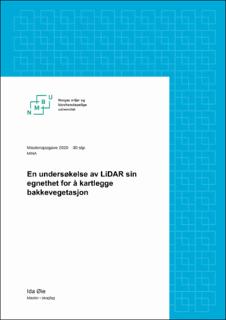| dc.contributor.advisor | Ohlson, Mikael | |
| dc.contributor.advisor | Hauglin, Marius | |
| dc.contributor.advisor | Storaunet, Ken Olaf | |
| dc.contributor.author | Øie, Ida | |
| dc.coverage.spatial | Norway, Hedmark, Stange, Romedal | en_US |
| dc.date.accessioned | 2021-01-02T15:58:31Z | |
| dc.date.available | 2021-01-02T15:58:31Z | |
| dc.date.issued | 2020 | |
| dc.identifier.uri | https://hdl.handle.net/11250/2721180 | |
| dc.description.abstract | LiDAR er i dag benyttet til mange formål, men er mest benyttet i skoginventering og terrengmodellering. Det sier altså noe om hva som befinner seg i det øverste vegetasjonssjiktet – skogen, og det som befinner seg helt nederst, altså bakken. Men hva med det som er midt imellom – altså bakkevegetasjonen? Formålet med denne oppgaven var å undersøke om LiDAR kunne anvendes til å finne informasjon om bakkevegetasjonen. Mine funn indikerer at LiDAR kan anvendes til å finne informasjon om bakkevegetasjonen, og at laservariablene for høyde og kronetetthet er bedre egent til å si noe om bakkevegetasjonen enn laservariablene hvor alle bakketreff og alle treff over 3 meter ikke er med. Grunnene til dette kan være flere ting, men siden LiDAR er mye brukt i skoginventering gir den mye informasjon om trærne, og det kan godt tenkes at informasjonen om trærne også indirekte kan gi oss informasjon om hva som befinner seg under trekronene. En annen er at kronetettheten blant trær vil variere, og noen vil være tettere enn andre og de som har litt sparsomme kroner tillater kanskje flere laserpulser å komme ned gjennom trekronene. Mine funn viser at LiDAR kan brukes til å finne informasjon om bakkevegetasjon. | en_US |
| dc.description.abstract | LiDAR is used for many purposes today, but it is mostly used for doing forest inventory and terrain modelling. It tells us something about what the upper vegetation layer meaning the trees and what can be found all the way at the bottom of the forest meaning the ground. But what about the layer in between these two, the ground vegetation? The purpose of this study is examining whether or not LiDAR can be used to find information about the ground vegetation. My findings indicate that LiDAR can be used for finding information about ground vegetation and that the laser variables saying something about height and crown density are better fitted for saying something about ground vegetation than the laser variables where all hits on ground level and all hits above 3 meters are excluded. The reasons for this may be several, but since the LiDAR is much used for doing forest inventory it provides information about the trees, and it might be that the information about the trees also indirectly can provide information about what is hiding underneath the canopies. Another reason for this might be that the canopy density among trees will vary, some of the canopies will be denser than others, and those that have more sparse canopies may allow more of the laser pulses to go through the canopies. My findings show that LiDAR can be used for finding information about ground vegetation. | en_US |
| dc.language.iso | nob | en_US |
| dc.publisher | Norwegian University of Life Sciences, Ås | en_US |
| dc.rights | Attribution-NonCommercial-NoDerivatives 4.0 Internasjonal | * |
| dc.rights.uri | http://creativecommons.org/licenses/by-nc-nd/4.0/deed.no | * |
| dc.title | En undersøkelse av LiDAR sin egnethet for å kartlegge bakkevegetasjon | en_US |
| dc.type | Master thesis | en_US |
| dc.description.localcode | M-SF | en_US |

